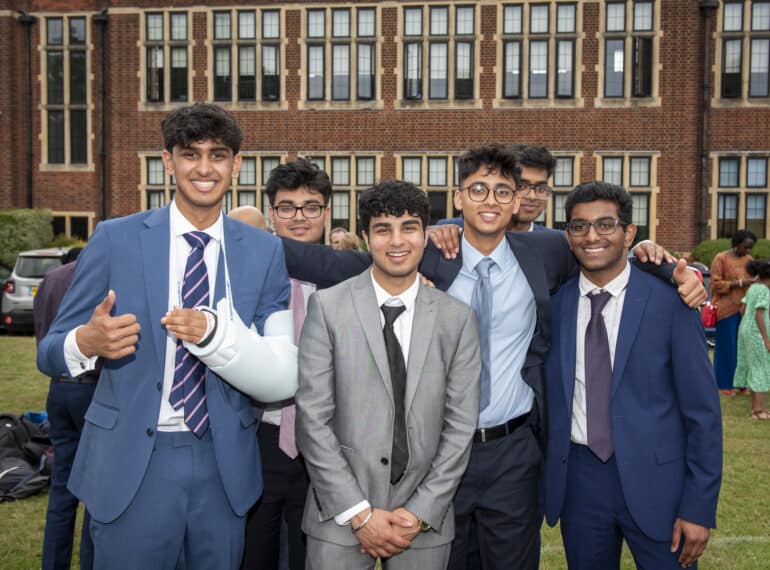
QE’s Valediction event for the Class of 2023 saw the 450th anniversary year cohort gather with their parents for an afternoon celebration.
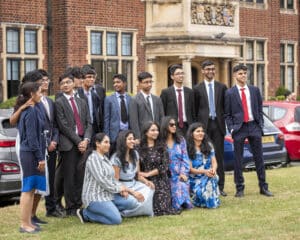 There were prizes for some, while the contribution of all the leavers – or graduands – was celebrated during an occasion in Shearly Hall that featured speeches and presentations, followed by afternoon tea on Staplyton Field.
There were prizes for some, while the contribution of all the leavers – or graduands – was celebrated during an occasion in Shearly Hall that featured speeches and presentations, followed by afternoon tea on Staplyton Field.
The guest speaker was Sahil Handa (OE 2009–2016), the first-ever Elizabethan to take up a place at Harvard in the US, who has already blazed a trail in several different fields, from the arts to founding IT startups.
As befitting an event which embraced a sense of fun alongside its formal aspects, the afternoon’s musical interludes looked to the lighter side: staff reportedly enjoyed processing in to the accompaniment of Michael Jackson’s Billie Jean, performed by the QE Jazz Lounge.
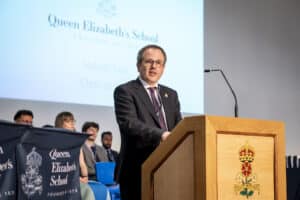 Headmaster Neil Enright thanked parents for their “huge support, both moral and financial, over the years” and urged both them and their sons to stay in touch with the School.
Headmaster Neil Enright thanked parents for their “huge support, both moral and financial, over the years” and urged both them and their sons to stay in touch with the School.
He told the boys: “I hope in the years to come that you will come back and see us; tell us about your adventures and careers; and, more importantly, tell those following in your footsteps through the School: that you will show them and their families the great variety of things that an OE can do, and an Elizabethan can be.”
The guest speaker was himself an example of that variety. Currently a Visiting Fellow at The John Hopkins University in Baltimore, Sahil is, among many other things:
- A writer: he was a founder of Persuasion, a non-profit magazine devoted to liberal values and the defence of free speech
- An entrepreneur: he has worked on both Typos, a messaging app for creatives and Lines, a messaging app offering verifiable communications in the blockchain-based web3, for which his company has raised over $6.5m in funding
- A dancer: he ran the QE dance club for four years and lists “dance battles at nightclubs” among his present interests
- An artist: he was selected for the Royal Academy of Arts’ AttRAct scheme while at QE and still enjoys painting on canvas.
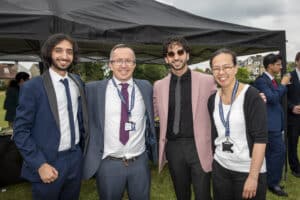 Sahil attended Valediction together with his mother, cousin, friends and his brother, Nikhil Handa (OE 2013–2020). He recalled his first encounter with Deputy Head (Pastoral) David Ryan, who hauled him over the coals after spotting him dancing outside the classroom window to entertain his classmates during afternoon form time. This less-than-auspicious beginning soon turned into a supportive relationship, however, when he became part of Mr Ryan’s English class. “I thought he’d make my life miserable. But to my surprise, it seemed as though he’d forgotten the whole episode entirely. I went on to learn everything from him… Mr Ryan was also the first person who complimented me for being a generalist.”
Sahil attended Valediction together with his mother, cousin, friends and his brother, Nikhil Handa (OE 2013–2020). He recalled his first encounter with Deputy Head (Pastoral) David Ryan, who hauled him over the coals after spotting him dancing outside the classroom window to entertain his classmates during afternoon form time. This less-than-auspicious beginning soon turned into a supportive relationship, however, when he became part of Mr Ryan’s English class. “I thought he’d make my life miserable. But to my surprise, it seemed as though he’d forgotten the whole episode entirely. I went on to learn everything from him… Mr Ryan was also the first person who complimented me for being a generalist.”
Sahil spoke of: the trials and tribulations of being a writer – “if I did not write, I would not be true to myself”; the importance of confidence and of learning from rejection, and of “maintaining and strengthening the relationships that matter”.
In conclusion, he alluded to the former TV show, Takashi’s Castle. “There’s an activity where contestants try to skip across stones on a lake, avoiding falling into the sea. I like to imagine. It’s how I feel when I’m dancing: like melodies are being created for my feet. You are now leaving a place of constraints and the world will create stones for you, if only you skip. Write the email. Ask the question. Start the conversation. Say the tough thing. Make the difficult choice. Take a posture towards the world that makes you look up and laugh at its wonder. It’ll be as though somebody is creating stones for you to walk on.”
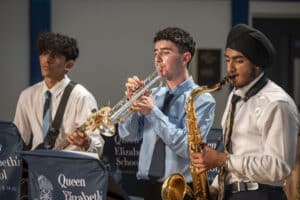 A large majority of Year 13 students attended. All received a set of QE cufflinks, while the prizewinners also received a copy of former Headmaster Dr John Marincowitz’s new history of the School, Queen Elizabeth’s School: 1573–2023. Among the speakers was Theo Mama-Kahn, School Captain 2022, who was one of the leavers. He gave a vote of thanks.
A large majority of Year 13 students attended. All received a set of QE cufflinks, while the prizewinners also received a copy of former Headmaster Dr John Marincowitz’s new history of the School, Queen Elizabeth’s School: 1573–2023. Among the speakers was Theo Mama-Kahn, School Captain 2022, who was one of the leavers. He gave a vote of thanks.
During tea afterwards, there were performances by four forms who shone recently in an inter-House music competition.
Speaking afterwards, Mr Enright said: “We began a Valediction event both because we wanted to say farewell formally as a School, but also to give people an opportunity to say their own goodbyes: the chats and well-wishing out on the field, with boys, families and staff thanking each other for all they have done over the past seven years, was an important element of the occasion.
“The Class of 2023 have distinguished themselves not only as a highly able cohort, but one characterised by kindness and positivity. They have served as great ambassadors to those younger in the School and I look forward to them continuing this record within our alumni community.”

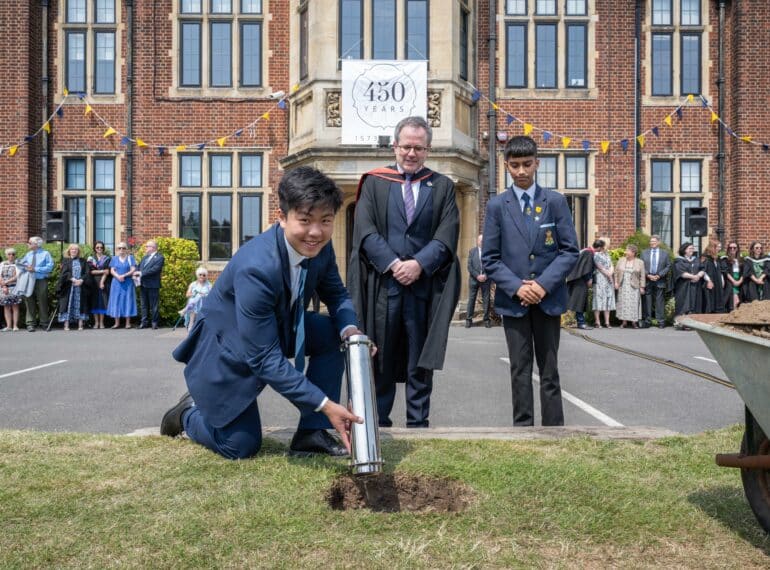
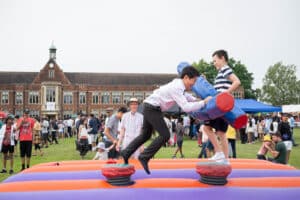 Always a highlight of the School calendar, Founder’s Day this year featured a string of anniversary-related special events, including the burial of a time capsule, as well as time-honoured traditions, from the reading of the School Chronicle to a cricket match between the current School XI and alumni.
Always a highlight of the School calendar, Founder’s Day this year featured a string of anniversary-related special events, including the burial of a time capsule, as well as time-honoured traditions, from the reading of the School Chronicle to a cricket match between the current School XI and alumni.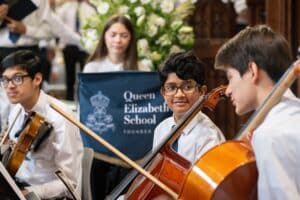 Headmaster Neil Enright said: “Our anniversary slogan is ‘thriving from ancient roots’ – and Founder’s Day 2023 exemplified this to the full. In the morning we reflected together on our long and rich history in the thanksgiving service at the parish church, while the happy crowds at our colourful afternoon fete were a reminder of just how vibrant and successful is the Elizabethan community of today.
Headmaster Neil Enright said: “Our anniversary slogan is ‘thriving from ancient roots’ – and Founder’s Day 2023 exemplified this to the full. In the morning we reflected together on our long and rich history in the thanksgiving service at the parish church, while the happy crowds at our colourful afternoon fete were a reminder of just how vibrant and successful is the Elizabethan community of today.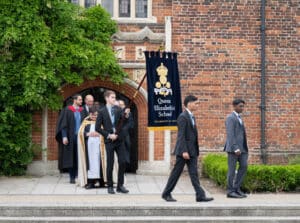 “My thanks go to the small army of people – including FQE volunteers, staff and pupils – who made the day such a success, and to the many who contributed so generously to maximising FQE’s income, which will be invested in the School.
“My thanks go to the small army of people – including FQE volunteers, staff and pupils – who made the day such a success, and to the many who contributed so generously to maximising FQE’s income, which will be invested in the School.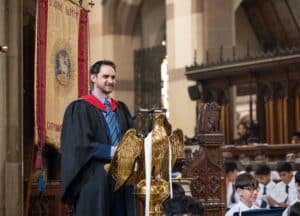 There, Giles Martin (OE 1992–1999) the son of the Chairman of Governors and the Programme Leader for Higher Education Practice at Bath Spa University’s School of Education, reminded the boys and wider congregation of the words of Gandhi: “Live as if you were to die tomorrow. Learn as it you were to live forever.”
There, Giles Martin (OE 1992–1999) the son of the Chairman of Governors and the Programme Leader for Higher Education Practice at Bath Spa University’s School of Education, reminded the boys and wider congregation of the words of Gandhi: “Live as if you were to die tomorrow. Learn as it you were to live forever.”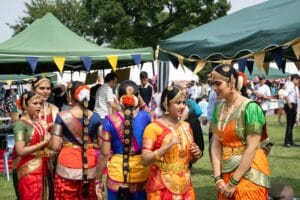 School Captain Darren Lee, of Year 12, stepped forward to fill the deep hole dug for the time capsule. This included:
School Captain Darren Lee, of Year 12, stepped forward to fill the deep hole dug for the time capsule. This included: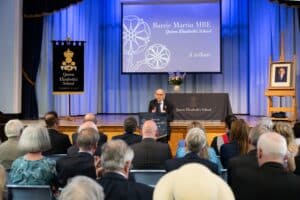 A photographic portrait of Barrie will be placed in the ‘crush hall’ in the Main Building upon his retirement. It was taken by the School’s photographer Eleanor Bentall, who has also taken portraits of subjects including Boris Johnson, former Archbishop of Canterbury Dr Rowan Williams, Clare Balding and Tinie Tempah.
A photographic portrait of Barrie will be placed in the ‘crush hall’ in the Main Building upon his retirement. It was taken by the School’s photographer Eleanor Bentall, who has also taken portraits of subjects including Boris Johnson, former Archbishop of Canterbury Dr Rowan Williams, Clare Balding and Tinie Tempah. The ever-popular international food tents were extended this year, while there was a range of impressive culinary creations battling it out in the Cake Competition. Additional attractions included a VEX Robotics tent – popular with parents as much as anyone! – and Ju Jitsu, where, rumour has it, Barrie Martin was seen performing a martial arts hold.
The ever-popular international food tents were extended this year, while there was a range of impressive culinary creations battling it out in the Cake Competition. Additional attractions included a VEX Robotics tent – popular with parents as much as anyone! – and Ju Jitsu, where, rumour has it, Barrie Martin was seen performing a martial arts hold. At the back of the School, the Stanley Busby Memorial Cricket Match on Third Field saw the old boys claiming what Head of Cricket Richard Scally described as “a well-deserved victory”. He added: “Both openers for the OEs – Omar Mohamed and Shahil Sheth – scored quickly, amassing 50 runs each and setting a challenging total of 159. In reply, the School lost early wickets and the run rate became too high, and although there was some strong resistance from Year 12’s Rohan Belavadi and Ranvir Sinha, it all proved too little too late, and the old boys won by 39 runs.”
At the back of the School, the Stanley Busby Memorial Cricket Match on Third Field saw the old boys claiming what Head of Cricket Richard Scally described as “a well-deserved victory”. He added: “Both openers for the OEs – Omar Mohamed and Shahil Sheth – scored quickly, amassing 50 runs each and setting a challenging total of 159. In reply, the School lost early wickets and the run rate became too high, and although there was some strong resistance from Year 12’s Rohan Belavadi and Ranvir Sinha, it all proved too little too late, and the old boys won by 39 runs.”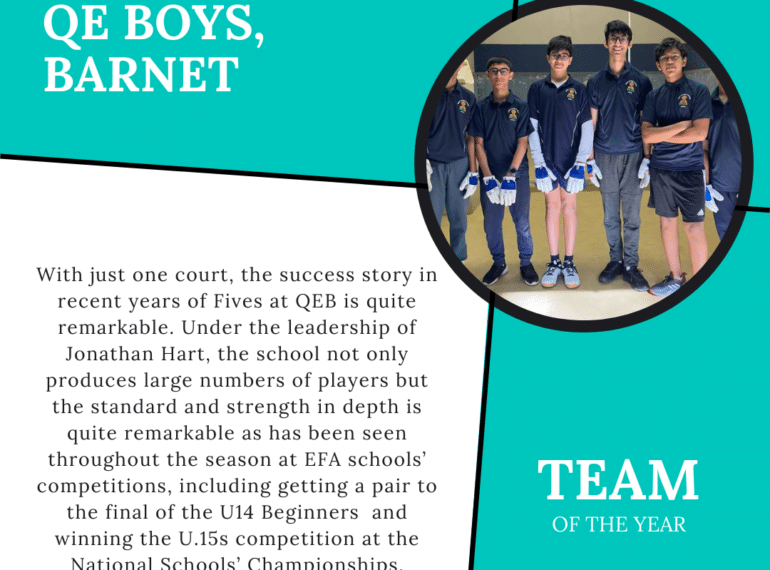
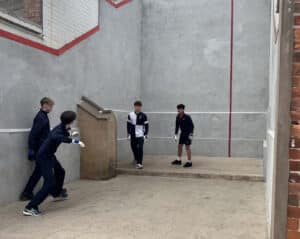 Having last year won the Eton Fives Association’s U14 Beginners’ competition, the Year 10 QE pair of Yash Kedia and Zayn Phoplankar went one better this season, becoming fully fledged U15 champions after beating Berkhamsted School’s best in the National Schools’ Championship. It is thought to be the first-ever national championship title for a QE Fives pairing.
Having last year won the Eton Fives Association’s U14 Beginners’ competition, the Year 10 QE pair of Yash Kedia and Zayn Phoplankar went one better this season, becoming fully fledged U15 champions after beating Berkhamsted School’s best in the National Schools’ Championship. It is thought to be the first-ever national championship title for a QE Fives pairing.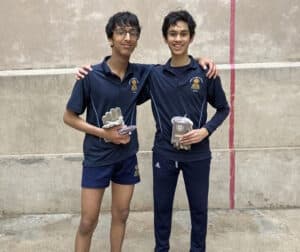 QE’s association with the sport goes back more than 140 years. Its first Fives courts at QE were opened at the School’s previous Wood Street premises in 1880, following a £10 grant from the Governors and a special fund-raising concert.
QE’s association with the sport goes back more than 140 years. Its first Fives courts at QE were opened at the School’s previous Wood Street premises in 1880, following a £10 grant from the Governors and a special fund-raising concert.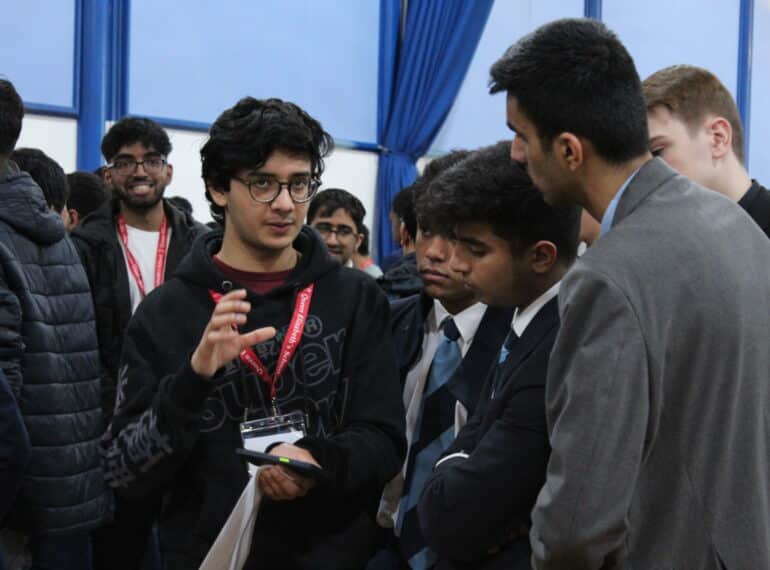
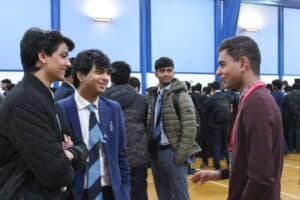 Organised as part of the QE’s extensive programme to support boys preparing for the next stage in their education, the morning event aims to provide detailed and specific guidance to the current Year 12.
Organised as part of the QE’s extensive programme to support boys preparing for the next stage in their education, the morning event aims to provide detailed and specific guidance to the current Year 12. “It is so valuable for our current students to get first-hand information – the inside track – from those studying on courses and at destinations they are considering, helping them very much with the choices that they will be making later in the year,” said Mr Enright.
“It is so valuable for our current students to get first-hand information – the inside track – from those studying on courses and at destinations they are considering, helping them very much with the choices that they will be making later in the year,” said Mr Enright.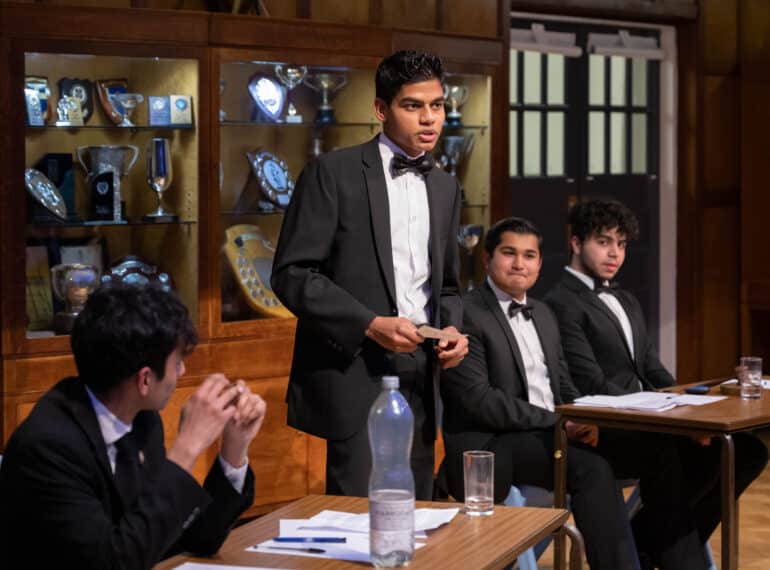
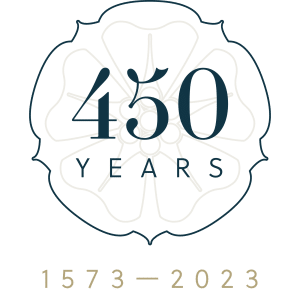 Sixth-formers gathered to take on the visiting Old Elizabethans, debating the motion, This House would leave the past behind us.
Sixth-formers gathered to take on the visiting Old Elizabethans, debating the motion, This House would leave the past behind us.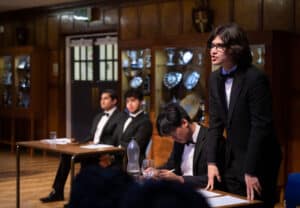 “The dinner participants also made a little bit of history themselves: our 2022 School, Captain Theo Mama-Kahn, led the loyal toast to ‘The King’, rather than ‘The Queen’, for the first time in the Dinner Debate’s history.”
“The dinner participants also made a little bit of history themselves: our 2022 School, Captain Theo Mama-Kahn, led the loyal toast to ‘The King’, rather than ‘The Queen’, for the first time in the Dinner Debate’s history.”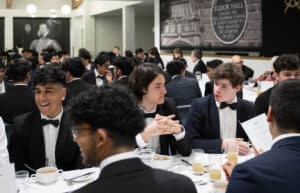 The motion was proposed by the Year 13 pair of Ashwin Sridhar and Sudhamshu Gummadavelly. Opposing it with Saifullah was Mipham Samten (OE 2012–2019). Many Year 13s contributed from the floor.
The motion was proposed by the Year 13 pair of Ashwin Sridhar and Sudhamshu Gummadavelly. Opposing it with Saifullah was Mipham Samten (OE 2012–2019). Many Year 13s contributed from the floor.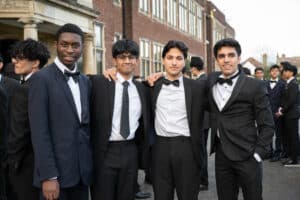 However, at the end of the debate, the proposers’ case had won many over, and the final totals were: 76 for; 55 against; and 39 abstentions. Thus, it was a victory for the School, the Upper Sixth pair successfully convincing people that the past could be left behind, even while its lessons were still being learned.
However, at the end of the debate, the proposers’ case had won many over, and the final totals were: 76 for; 55 against; and 39 abstentions. Thus, it was a victory for the School, the Upper Sixth pair successfully convincing people that the past could be left behind, even while its lessons were still being learned.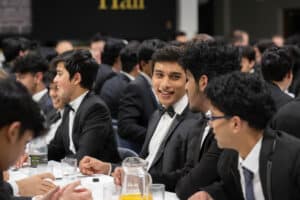 The experience heralded an era of competition success for Saifullah: he has now a record ten mooting and mock trial competitions, and has been a student speaker in six Cambridge Union Debates, the most in recent history.
The experience heralded an era of competition success for Saifullah: he has now a record ten mooting and mock trial competitions, and has been a student speaker in six Cambridge Union Debates, the most in recent history.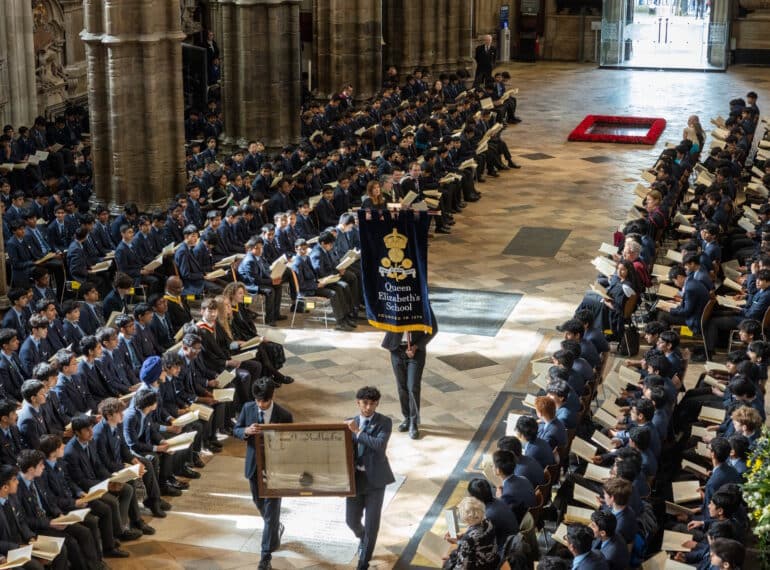
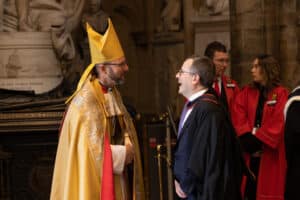 The service included religious and literary readings, with Year 11 pupil Rohan Kumar’s winning entry in the School’s 450th Anniversary Poetry Competition, and music from every century of the School’s existence, culminating in a premiere performance of an anthem commissioned from internationally renowned composer Howard Goodall.
The service included religious and literary readings, with Year 11 pupil Rohan Kumar’s winning entry in the School’s 450th Anniversary Poetry Competition, and music from every century of the School’s existence, culminating in a premiere performance of an anthem commissioned from internationally renowned composer Howard Goodall.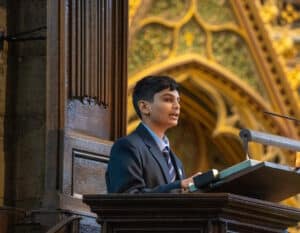 Drawing an analogy with Jesus’s parable of the foolish man who built a house on the sand and the wise man who built his house on the rock, Mr Enright said: “There have been many times over the past 450 years when the rain descended and the floods came and the wind blew and the School’s foundations were tested.”
Drawing an analogy with Jesus’s parable of the foolish man who built a house on the sand and the wise man who built his house on the rock, Mr Enright said: “There have been many times over the past 450 years when the rain descended and the floods came and the wind blew and the School’s foundations were tested.”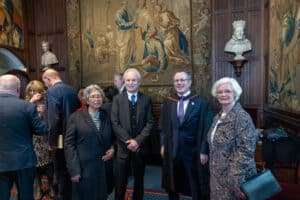 “Over the past 450 years, our remarkable school has often flourished, and always survived,” said Mr Enright.
“Over the past 450 years, our remarkable school has often flourished, and always survived,” said Mr Enright.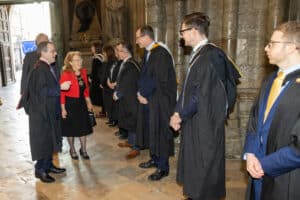 Before the service, the congregation listened to the orchestra’s performance of William Walton’s Crown Imperial and the Indian Ensemble’s performance of Tani Avartaram.
Before the service, the congregation listened to the orchestra’s performance of William Walton’s Crown Imperial and the Indian Ensemble’s performance of Tani Avartaram.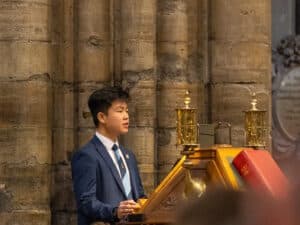 The Headmaster said the traditional Founder’s Day prayer, while others leading in prayer included Mrs Emi Aghdiran, Governor and Director of FQE, and Matthew Rose (OE 2002–09), Head of External Relations.
The Headmaster said the traditional Founder’s Day prayer, while others leading in prayer included Mrs Emi Aghdiran, Governor and Director of FQE, and Matthew Rose (OE 2002–09), Head of External Relations.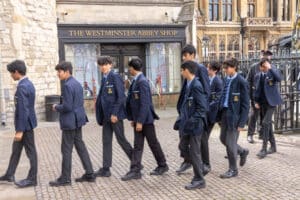 That like an oak, it draws its strength
That like an oak, it draws its strength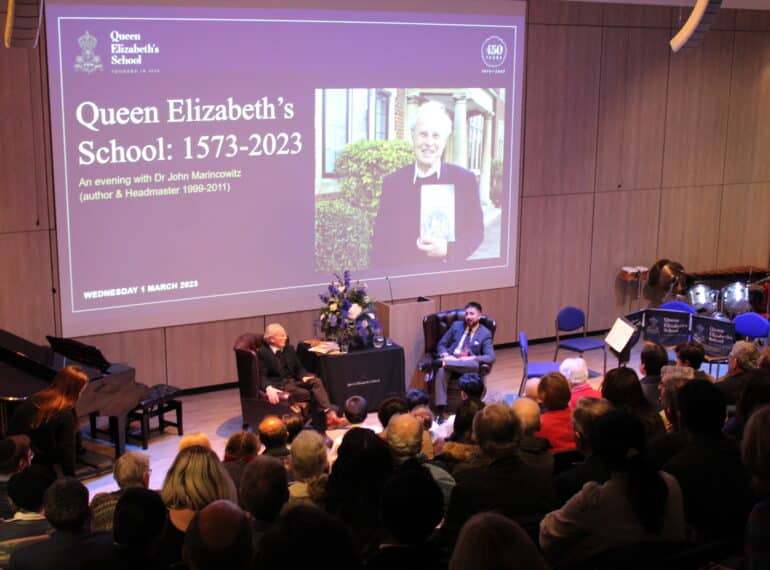
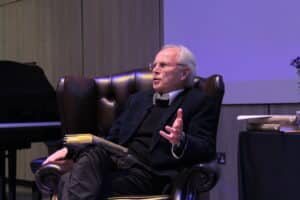 The relaxed evening event at the School drew alumni, former staff, governors and trustees, current and former parents, current boys, and other supporters of the School, as well as visitors from the local community. It was held as one of the events marking
The relaxed evening event at the School drew alumni, former staff, governors and trustees, current and former parents, current boys, and other supporters of the School, as well as visitors from the local community. It was held as one of the events marking  All profits from the sale of the book will go to The Friends of Queen Elizabeth’s (FQE) for reinvestment into the School.
All profits from the sale of the book will go to The Friends of Queen Elizabeth’s (FQE) for reinvestment into the School.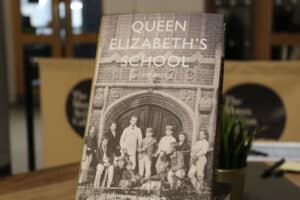 “It was fascinating to learn more about what John had uncovered through his research about this remarkable School’s rich history. His work has made a significant contribution to our understanding of the School and the context in which it has evolved over the centuries.
“It was fascinating to learn more about what John had uncovered through his research about this remarkable School’s rich history. His work has made a significant contribution to our understanding of the School and the context in which it has evolved over the centuries.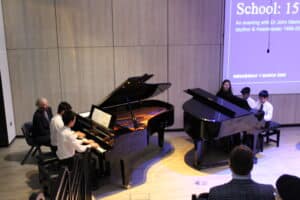 “Moreover, I was encouraged that when asked, John was fully confident that the School would still be thriving in its current location in 50 years’ time for the 500th anniversary!”
“Moreover, I was encouraged that when asked, John was fully confident that the School would still be thriving in its current location in 50 years’ time for the 500th anniversary!”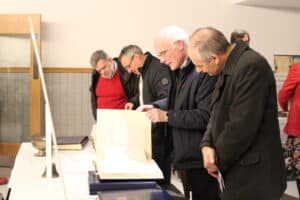 The School’s 1573 Royal Charter;
The School’s 1573 Royal Charter;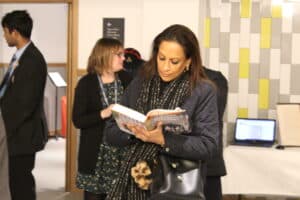 During the evening, assistance was provided by prefects and by a small number of those who have been involved with the School archives, either as part of the QE palaeography group or through Duke of Edinburgh Award scheme volunteering.
During the evening, assistance was provided by prefects and by a small number of those who have been involved with the School archives, either as part of the QE palaeography group or through Duke of Edinburgh Award scheme volunteering.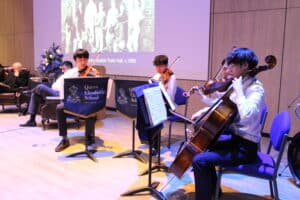 As the evening progressed, there were readings from the book and the discussion between Dr Marincowitz (Headmaster, 1999–2011) and Surya (OE 2007–2014).
As the evening progressed, there were readings from the book and the discussion between Dr Marincowitz (Headmaster, 1999–2011) and Surya (OE 2007–2014).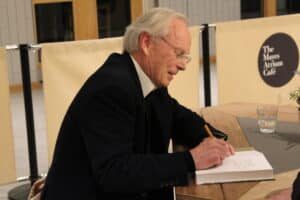 The final musical contribution came from a second piano quartet, comprising Zeyuan Wu (Year 11), Joshua John (Year 11), Zehao Wu (Year 8) and Felix Chen (Year 8), playing Saint-Saens’s Danse Macabre, arranged for eight hands. All the musical items were selected because they were based on literary stories or plays.
The final musical contribution came from a second piano quartet, comprising Zeyuan Wu (Year 11), Joshua John (Year 11), Zehao Wu (Year 8) and Felix Chen (Year 8), playing Saint-Saens’s Danse Macabre, arranged for eight hands. All the musical items were selected because they were based on literary stories or plays.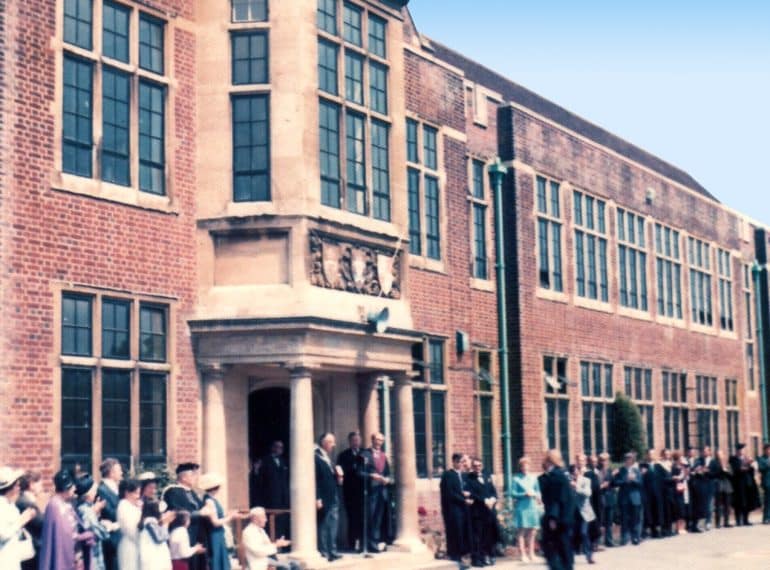
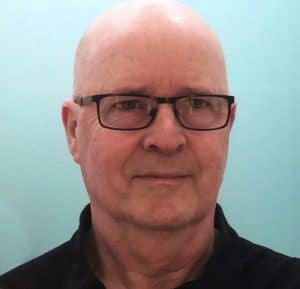 “My favourite memory of the 400th anniversary was organising the School fete. I persuaded the school to hold a joint fete with the Girls’ School and for the proceeds to go to the new Marie Foster home for multiple sclerosis about to be opened in Wood Street.
“My favourite memory of the 400th anniversary was organising the School fete. I persuaded the school to hold a joint fete with the Girls’ School and for the proceeds to go to the new Marie Foster home for multiple sclerosis about to be opened in Wood Street.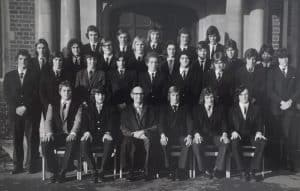 Iain was a keen sportsman. He was captain of the athletics team and played rugby on the left wing in the First XV, also playing for the county in both sports. He was the Borough of Barnet schools 100 metres sprint champion for two years. “My time of 11.2 seconds was a record that stood for several years, I think.”
Iain was a keen sportsman. He was captain of the athletics team and played rugby on the left wing in the First XV, also playing for the county in both sports. He was the Borough of Barnet schools 100 metres sprint champion for two years. “My time of 11.2 seconds was a record that stood for several years, I think.”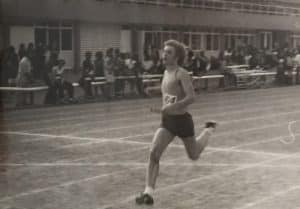 After Iain finally handed over the School Captain’s mantle to Maxwell Ball, who took over in the Autumn Term of 1973, he went on to his own English Literature degree at Warwick.
After Iain finally handed over the School Captain’s mantle to Maxwell Ball, who took over in the Autumn Term of 1973, he went on to his own English Literature degree at Warwick.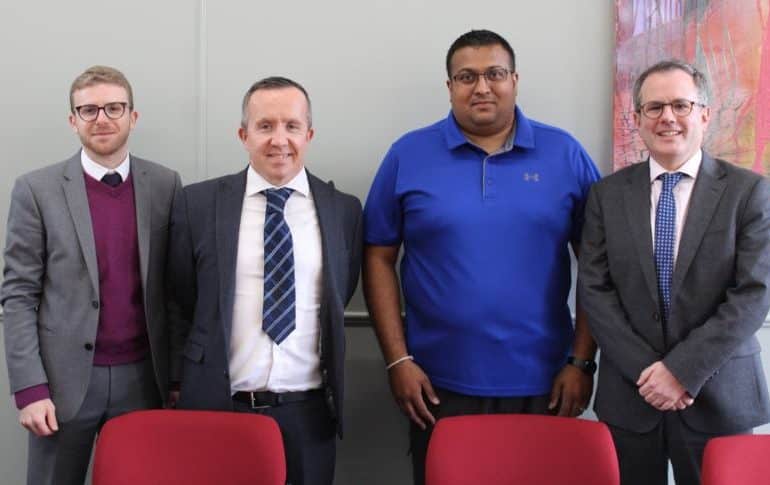
 One highlight that sticks in his mind is the research & presentation course he took. “I really enjoyed that class the most, partly because it prepared you for public speaking. Also, at that time, you didn’t Google everything: it was all about going to the library and trying to do some research. Teaching that is not something that every school does.
One highlight that sticks in his mind is the research & presentation course he took. “I really enjoyed that class the most, partly because it prepared you for public speaking. Also, at that time, you didn’t Google everything: it was all about going to the library and trying to do some research. Teaching that is not something that every school does.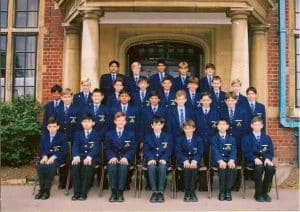 It was while establishing himself in this job that through a family friend he met Michael Bernstein, a senior figure working in New York’s accountancy scene. “I call him my Jewish father: to survive in New York , you need a Jewish father!” He invited Raj to come and work in the US and so, on September 23rd 2006, he moved across the Atlantic, starting work on 1st October from offices opposite Bloomingdale’s, the famous department store.
It was while establishing himself in this job that through a family friend he met Michael Bernstein, a senior figure working in New York’s accountancy scene. “I call him my Jewish father: to survive in New York , you need a Jewish father!” He invited Raj to come and work in the US and so, on September 23rd 2006, he moved across the Atlantic, starting work on 1st October from offices opposite Bloomingdale’s, the famous department store.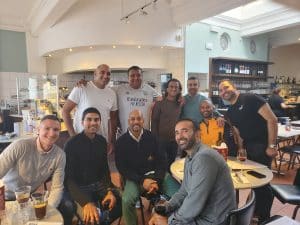 Reflecting on his life and career, Raj is clear about the benefits that QE has brought him. “QE actually did give us a good grounding. At that stage of your life, it’s important to have some discipline and sense of responsibility. There are of course always two ways of looking at things, but I think QE does teach you responsibility and it does give you the skillset to build your career in the way you want to.”
Reflecting on his life and career, Raj is clear about the benefits that QE has brought him. “QE actually did give us a good grounding. At that stage of your life, it’s important to have some discipline and sense of responsibility. There are of course always two ways of looking at things, but I think QE does teach you responsibility and it does give you the skillset to build your career in the way you want to.”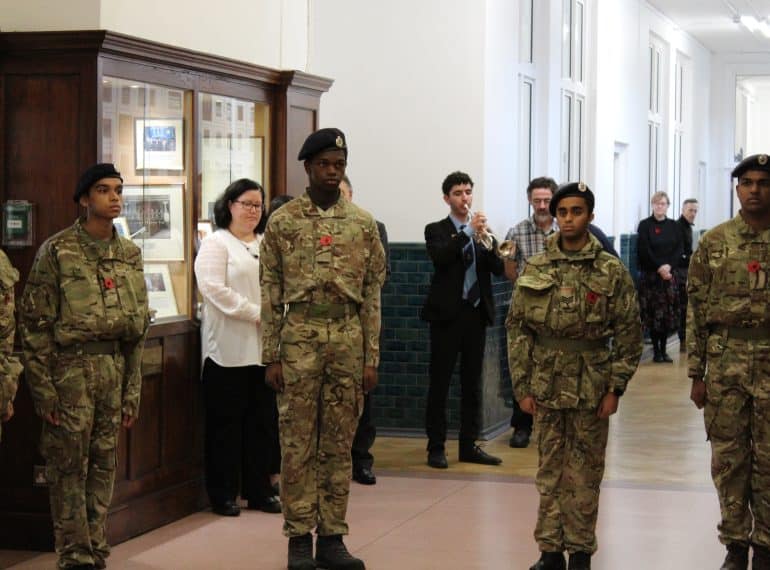
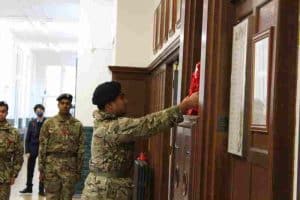 Through the two events, today’s Elizabethans remembered the 113 old boys who lost their lives in the 20th century’s two world wars and those who have been injured or died in wars since.
Through the two events, today’s Elizabethans remembered the 113 old boys who lost their lives in the 20th century’s two world wars and those who have been injured or died in wars since.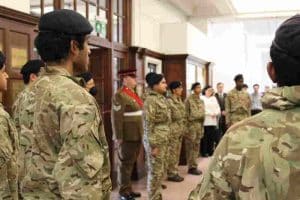 QE’s traditional 11.00am act of remembrance took place at the School’s World War I memorial in the Crush Hall. It was led by representatives of the School’s Combined Cadet Force, who were joined by Colour Sergeant Rhys Peto, the CCF’s School Staff Instructor, who is a member of QE’s Facilities Team.
QE’s traditional 11.00am act of remembrance took place at the School’s World War I memorial in the Crush Hall. It was led by representatives of the School’s Combined Cadet Force, who were joined by Colour Sergeant Rhys Peto, the CCF’s School Staff Instructor, who is a member of QE’s Facilities Team.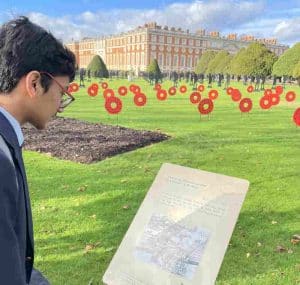 Two days later, 36 of the School’s cadets and CCF staff representatives participated in High Barnet’s Remembrance Sunday events. After assembling at Barnet Army Reserve centre in St Albans Road, they paraded down Barnet High Street and joined the church service at St John the Baptist Church, where there was the playing of the Last Post and a wreath-laying ceremony. Events concluded with a march-past, where Martin Russell, the Representative Deputy Lieutenant for the London Borough of Barnet (and the parent of an Old Elizabethan) took the salute.
Two days later, 36 of the School’s cadets and CCF staff representatives participated in High Barnet’s Remembrance Sunday events. After assembling at Barnet Army Reserve centre in St Albans Road, they paraded down Barnet High Street and joined the church service at St John the Baptist Church, where there was the playing of the Last Post and a wreath-laying ceremony. Events concluded with a march-past, where Martin Russell, the Representative Deputy Lieutenant for the London Borough of Barnet (and the parent of an Old Elizabethan) took the salute.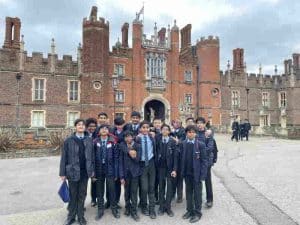 Helen Edmunds, Head of History & Politics, said: “Hampton Court provides excellent contemporary sources, including a display of diaries and letters written by the soldiers who were there just over a century ago. This links in well in with the work our pupils will do next year when they enter Year 9 on the role and importance of Empire troops during World War I and World War II.
Helen Edmunds, Head of History & Politics, said: “Hampton Court provides excellent contemporary sources, including a display of diaries and letters written by the soldiers who were there just over a century ago. This links in well in with the work our pupils will do next year when they enter Year 9 on the role and importance of Empire troops during World War I and World War II.